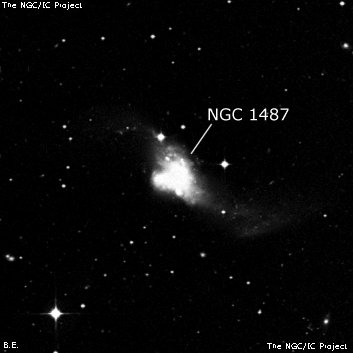
James Dunlop discovered NGC 1487 = D 480 = h2597 on 29 Oct 1826 with his 9" reflector and described "a very faint ill-defined nebula, with two or three very small stars in it, and a small star following." There is nothing at his position, but 83 seconds of RA west is the interacting system VV 78 = PGC 14117. Glen Cozens notes this is probably the faintest galaxy discovered by Dunlop (V = 11.9).
John Herschel observed this galaxy on 3 sweeps, first recording "pB, pL, R, 90"; makes a triangle with two stars 13th mag about 1 radius of nebula (by diagram) from its edge."
Joseph Turner sketched the galaxy on 26 Nov 1877 with the Great Melbourne Telescope (p. 151 of his logbook). He noted it had a mottled appearance and was "rather irregular in shape, of rather an oval form...the sp side is brider than the rest of the nebula." NGC 1487 is a distorted triple system.
400/500mm - 18" (1/17/09): fairly faint, moderately large, irregularly round, 1.8'x1.5', slightly elongated E-W, weak central brightening. Appears to have an irregular surface brightness, though viewed at a very low elevation from Lake Sonoma. Two mag 12.5-13 stars form an isosceles triangle with the galaxy 1.2' N and 1.2' W. On the DSS this is a distorted interacting system with two brighter condensations and long, faint tidal plumes. This object should be viewed from a more southerly latitude to see detail.
Notes by Steve Gottlieb